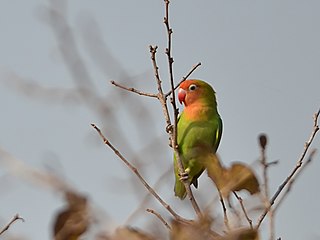
Lovebird is the common name for the genus Agapornis, a small group of parrots in the Old World parrot family Psittaculidae. Of the nine species in the genus, all are native to the African continent, with the grey-headed lovebird being native to the African island of Madagascar.

The rosy-faced lovebird, also known as the rosy-collared or peach-faced lovebird, is a species of lovebird native to the Namibian savanna woodlands. Loud and constant chirpers, these birds are very social animals and often congregate in small groups in the wild. They eat throughout the day and take frequent baths. Coloration can vary widely among populations. Plumage is identical in males and females. Lovebirds are renowned for their sleep position in which they sit side-by-side and turn their faces in towards each other. Also, females are well noted to tear raw materials into long strips, "twisty-tie" them onto their backs, and fly substantial distances back to make a nest. These birds are common in the pet industry.

Lilian's lovebird, also known as the Nyasa lovebird, is a small African parrot species of the lovebird genus. It is mainly green and has orange on its upper chest and head. It is 13 cm (5 inches) long and is the smallest parrot on mainland Africa. In captivity, it is uncommon and difficult to breed.

Fischer's lovebird is a small parrot species of the genus Agapornis. They were originally discovered in the late 19th century. They are named after German explorer Gustav Fischer.

The Northern Congolian forest–savanna mosaic is a forest and savanna ecoregion of central Africa. It extends east and west across central Africa, covering parts of Cameroon, Central African Republic, Democratic Republic of the Congo, South Sudan, and Uganda. It is part of the belt of transitional forest-savanna mosaic that lie between Africa's moist equatorial Guineo-Congolian forests and the tropical dry forests, savannas, and grasslands to the north and south.

The yellow-collared lovebird, also called masked lovebird, black-masked lovebird or eye ring lovebird, is a monotypic species of bird of the lovebird genus in the parrot family Psittaculidae. They are native to Arusha Region of Tanzania and have been introduced to Burundi and Kenya. Although they have been observed in the wild in Puerto Rico, they are probably the result of escaped pets, and no reproduction has been recorded. They have also been observed in Arizona.

Psittacinae is a subfamily of parrots, native to sub-Saharan Africa, which include twelve species and two extant genera. Among the species is the iconic grey parrot.

The red-headed lovebird, also known as the red-faced lovebird, is a member of the genus Agapornis, a group commonly known as lovebirds. Like other lovebirds it is native to Africa.

The black-cheeked lovebird is a small parrot species of the lovebird genus. It is mainly green and has a brown head, red beak, and white eyerings. It is endemic to a relatively small range in southwest Zambia, where it is vulnerable to habitat loss.

The gray-headed lovebird or Madagascar lovebird is a small species of parrot of the lovebird genus. It is a mainly green parrot. The species is sexually dimorphic and only the adult male has grey on its upper body. They are native on the island of Madagascar and are the only lovebird species which are not native on the African continent. They are the smallest of the lovebird species. It is rarely seen in aviculture and it is difficult to breed in captivity.

The black-winged lovebird also known as Abyssinian lovebird is a mainly green bird of the parrot family. At about 16.5 cm (6.5 inches) long, it is the largest of the lovebird genus, a group of small parrots. The adult male is easily identified by its red forehead, and the adult female by its all-green head. They are native to Eritrea and Ethiopia, and they are uncommon as pets.

The black-collared lovebird also known as Swindern's lovebird is a small, 13.5cm (5in) long, African parrot in the genus Agapornis and belongs to the Agapornithinae family. The black-collared lovebird is widespread across the African tropical closed rainforest. It is a mostly green parrot with black band on the back of its neck, and a dark greyish-black bill. Both sexes are similar. It is rarely kept in captivity because of its dietary requirement for a native fig.

The wildlife of Burundi is composed of its flora and fauna. The small, landlocked country is home to 2,950 species of plants, 596 birds, 163 species of mammals, 52 species of reptiles, 56 species of amphibians, and 215 fish species. The wildlife has been drastically reduced in recent years, mainly on account of intense population pressure, conversion of large areas of forest into agricultural land, and extensive livestock farming. The protected area encompasses little more than 5% of the total area of the country.

A feral parrot is a parrot that has adapted to life in an ecosystem to which it is not native. The birds are often descended from pets that have escaped or been deliberately released. Many species of parrots are highly social, and like to gather in large flocks. Not all feral parrots are able to adapt to life outside of captivity, although having a pre-existing nearby parrot colony can assist with the adaptation process.

The wildlife of Rwanda comprising its flora and fauna, in prehistoric times, consisted of montane forest in one third the territory of present-day Rwanda. However, natural vegetation is now mostly restricted to the three national parks and four small forest reserves, with terraced agriculture dominating the rest of the country.

The science of rosy-faced lovebird colour genetics deals with the heredity of colour variation in the feathers of the species known as Agapornis roseicollis, commonly known as the rosy-faced lovebird or peach-faced lovebird.

Birds of Eden is the world's largest free flight aviary and bird sanctuary, located in Kurland village near Plettenberg Bay in the Western Cape, South Africa. The mesh dome of the sanctuary was built over 2.3 hectares of indigenous forest, and is up to 55 metres (180 ft) above ground level. 1.2 kilometres (0.75 mi) of walkways, about 75% of which are elevated, let visitors see the birds at all levels of the aviary.

Agapornithinae is a subfamily of psittacine birds, one of the five subfamilies that make up the family Psittaculidae. Its members are small, short-tailed parrots that inhabit Africa and Asia. They usually have predominantly green plumage and present different colorations on the head.

Dirk Van den Abeele is a Flemish ornithologist, specializing in the genus Agapornis. He has written a number of books on this subject. Most of his books have been translated into English, Greek, Spanish, French, Czech, Italian and German. Since 1999, Van den Abeele is a member of MUTAVI, Research & Advice Group in The Netherlands, where he is conducting research, together with Inte Onsman, into pigmentation of the various colour mutations in birds. Together with the Australian veterinarian Terry Martin he collaborated on the 'International Agreements for Naming Colour Mutations in Psittaciformes'. He was chairman of BVA International, the Belgian Lovebird Society from 1999 till December 2010. Since 2011 he is honorary chairman of BVA-International.
Albrecht Manegold is a German ornithologist and paleontologist. He is the curator of the vertebrate collection at the State Museum of Natural History Karlsruhe. He is known for contributions to the study of early passerine evolution. He has described extinct passerines and piciformes including the fossil treecreeper Certhia rummeli and the fossil woodpecker Australopicus nelsonmandelai.


















